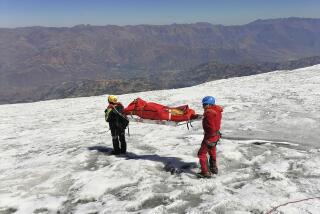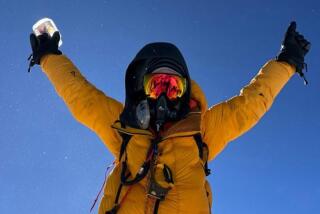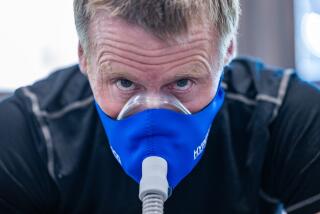Mallory’s Death Recalls Lost Era of Adventure
LONDON — The discovery of the frozen corpse of English mountaineer George Mallory nearly 75 years after his final assault on Mt. Everest has rekindled Britain’s fascination with its romantic adventurer and the mystery of his death.
British newspapers published photographs of Mallory’s torso lying face down in a field of scree at 27,000 feet, about 2,000 feet below the summit. His clothes, tattered by time and the elements, reveal a muscular back bleached to a marble white like a fallen Greek statue.
But more than the idealized body, it is the clothes that have recaptured Britain’s imagination. Mallory and climbing partner Andrew Irvine tried to scale Everest in “tweeds and hobnailed boots,” newspapers noted in awe.
At a time when Britain is engaged in a faltering, high-tech war in Yugoslavia, Mallory’s low-tech ascent in the 1920s seems to have particular appeal.
“The climbers had no fixed ropes, anchors or ladders; they wore cotton shells and wool sweaters and jackets; their rudimentary equipment tested endurance to the limit,” the Times of London wrote in an editorial last week. “Admiration grows with hindsight. Mallory was in a long tradition of English adventurers and sportsmen whose nonchalance and gentlemanly demeanor masked fierce ambition.”
Mallory perfected nonchalance and understatement with his response to the question why he wanted to scale the world’s highest mountain: “Because it is there.”
This is “the doggedness of just wanting to find out, to get to the top or the bottom for the sake of curiosity,” the Guardian newspaper enthused. “There remains something wonderful about the spirit of play that carries people into contests where there is no material reward, no point but the thing itself.”
Mallory was 38 and an experienced climber when he set out on his third attempt to scale Everest; Irvine was 22 and a novice compared with Britain’s golden boy of adventure.
To climb Everest was to battle 125-mph winds, sudden storms at subzero temperatures, rockslides and oxygen deprivation in unknown terrain. On June 8, 1924, the two men were spotted about 800 feet from the summit by geologist Noel Odell, another member of the team, who reported them “going strong” toward the top.
“My eyes became fixed on one tiny black spot silhouetted on a small snow-crest beneath a rock-step in the ridge; the black spot moved on. Another black spot became apparent and moved up the snow to join the other on the crest,” he wrote later. “Then the whole fascinating vision vanished, enveloped in cloud once more.”
The two were never seen alive again. Their disappearance “somewhere between heaven and earth,” as a memorial to Mallory says, gave birth to a national myth in the mold of explorer Robert Falcon Scott, who reached the South Pole but died on the return journey in 1912.
No one has ever known whether Mallory was the first man on top of the world’s highest mountain, nearly 30 years before Sir Edmund Hillary and Sherpa Tenzing Norgay set foot on the summit.
The Mallory and Irvine Research Expedition, from Ashford, Wash., which discovered the body, still cannot say.
Mallory’s body revealed a fractured leg and broken hemp rope tied around the waist, indicating that he and Irvine died in a fall. The researchers found a name tag sewn into his clothes and a letter from his wife in his breast pocket, but no clue as to whether the accident took place on the way up or down the mountain.
A Kodak pocket camera that Mallory was carrying still has not been found. It is assumed that if he had made it to the top he would have taken pictures, which Kodak says might have survived all these years in the freeze.
The expedition buried the body but brought back the photographs of it.
“It was very poignant to see what they achieved with so little knowledge and equipment,” said Stephen Venable, a British climber who scaled Everest in 1988.
Mallory’s son, John, told Britain’s Radio 4 that he believes his father may have made it to the top of the peak but too late in the day to return.
“Most people who don’t make the summit until somewhere near sunset don’t get down,” said John Mallory, 80. “To me, the only way you achieve a summit is to come back alive. The job’s half-done if you don’t get down again.”
More to Read
Sign up for The Wild
We’ll help you find the best places to hike, bike and run, as well as the perfect silent spots for meditation and yoga.
You may occasionally receive promotional content from the Los Angeles Times.






